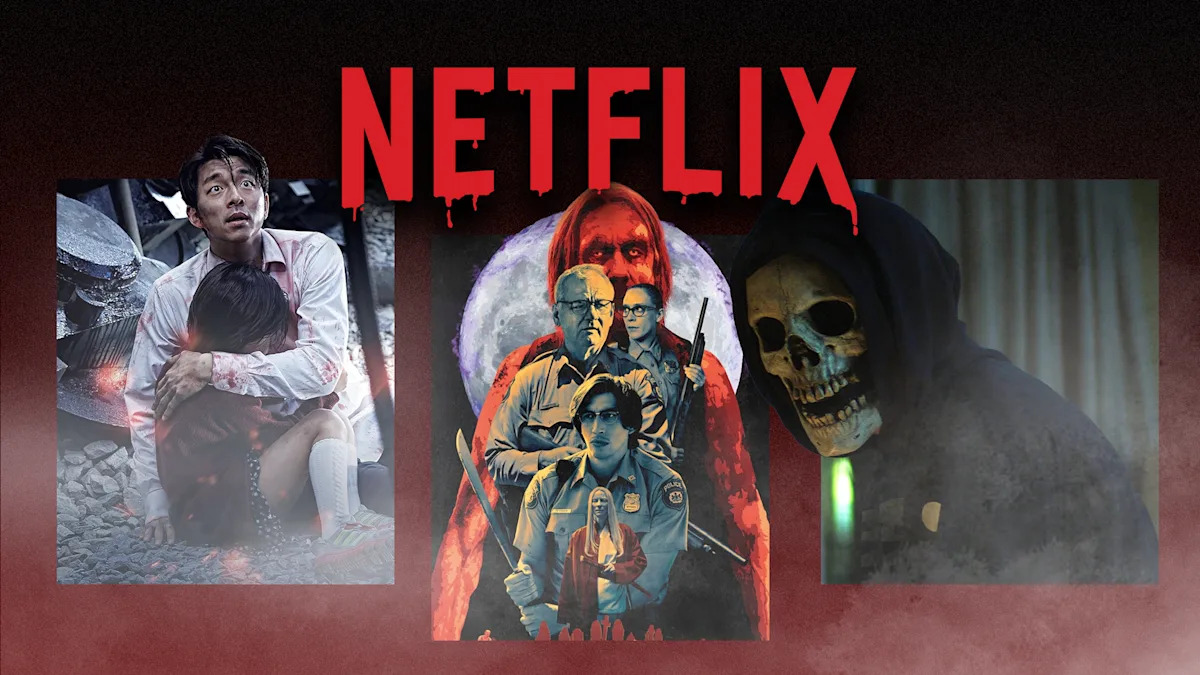
The 10 Best Horror Movies On Netflix Right Now
Netflix has plenty to offer from must-watch shows (Squid Game, Stranger Things) to award-worthy movies (The Irishman, Marriage Story). But what about horror? Whether it’s Halloween or not, sometimes you crave something terrifying in either zombie gore or psychological shock.
Thankfully, Netflix hasn’t skimped on the horror genre with all it currently offers. Their offerings span from slasher classics that defined that sub-genre to recent hits that tap into something deeply horrifying within the mind. Watch these new, old, and essential horror movies the next time you open up Netflix.
Zom 100: Bucket List of the Dead (2023)
Akira Tendo doesn’t have much to look forward to as a man in his 20s, becoming disillusioned with the modern world. But when a zombie apocalypse befalls Japan, it’s not the end of the world, but the beginning of a new adventure. With humanity now crumbled, an enthusiastic Akira can now pursue his many life goals without the worries of money
Based on the manga series written by Haro Aso and illustrated by Kotaro Takata, Zom 100 is an odd mixture of zombie horror and enthusiastic wish fulfillment. The offbeat tone is wildly refreshing for how it observes the brighter side of a zombie apocalypse and what it means to be human. The film is pretty fun and the manga was so revered that it would also be adapted into an anime series.
The Blackening (2022)
The slasher genre gets a hefty dose of racial satire in The Blackening. A group of black friends ventures off to a cabin for a vacation of sex, drugs, and booze on Juneteenth. They soon discover a racist board game in the house and are threatened by a mysterious figure who forces them to answer questions about black culture. And it only gets stranger from there.
The Blackening is a horror comedy that leans heavily into racial satire with biting humor amid its gruesome slashings. Much like Scream, it also toys with slasher movie conventions, where the surviving characters deeply question every move based on their knowledge of horror movies. With an ensemble relatively wise in who to trust and when to run, there’s a lot of fun in a film this absurd and astute with its satire.
Creep (2015)
Aaron (Patrick Brice) is a videographer who has accepted an odd request from the mysterious Josef (Mark Duplass). Desiring to be filmed for a day, Josef opens up to Aaron as their time together is recorded. The more that Aaron learns about Josef, however, the more he falls into a deadly trap of a psychologically disturbed man determined to frighten and attack.
Creep was one of the more compelling found-footage horror films of the 2010s because it focused more on the psychological than supernatural. Duplass gives an intoxicating performance as an exuberant man who is too weird to hang around and too dangerous to run away from. He was so good as this creepy killer that he reprised the role for the sequel, Creep 2, and the spin-off series, The Creep Tapes, streaming on Shudder.
The Dead Don’t Die (2019)
Director Jim Jarmusch went full deadpan on horror with The Dead Don’t Die. The film takes place in the rural community of Centerville, where various residents try to handle a zombie outbreak that befalls their town. The ensemble includes two bewildered police officers (Bill Murray, Adam Driver), a quirky farmer (Steve Buscemi), and the bizarre funeral home owner who favors swords (Tilda Swinton).
The Dead Don’t Die isn’t afraid to get absurd with its premise beyond watching a collective of celebrities attacked by zombies, ranging from RZA to Iggy Pop to Tom Waits. There’s a tongue-in-cheek tone to how the film approaches this violent invasion with passive commentary and dry jokes. The film even breaks the fourth wall in how one line of dialogue comments on how Jarmusch has run out of ideas for his script. If you like your zombie comedies meta and loaded with an all-star cast, this should satisfy that desire.
His House (2020)
Bol and Rial are Sudanese refugees who have found asylum in the United Kingdom, but their daughter did not survive the trip. While they try to settle down in their new English home, the two are haunted by dark thoughts of the past and a sinister force that lurks inside. What follows is a disturbing psychological tale of the somberness in grief and the anxiety in trying to start over in a new culture.
Written and directed by Remi Weekes, His House might have flown under the radar of many when it premiered in late October 2020, but it shouldn’t be overlooked. Wunmi Mosaku and Sope Dirisu turn in some brilliantly nuanced performances, and the surreal nature of their new home has some solid special effects to better embrace the thematic aspects. As a suspenseful and supernatural cocktail depicting the plight of refugees, this is a stirring tale of horror for those who want something more akin to The Babadook, where darker fears can manifest.
The Fear Street Trilogy (2021)
Set in the spooky town of Shadyside, the Fear Street trilogy takes place during different eras to showcase the terror that has festered. Part One features a series of surprising murders in 1994, Part Two shifts to a summer camp slaughter in 1978, and Part Three draws all the way back to 1666 before coming to a close back in the 1990s. Throughout the saga is a depiction of frightening teenage slashings where nobody is safe and few can be trusted in a story laced with deception and supernatural elements.
Based on the books by R.L. Stine of Goosebumps fame, Fear Street was surprisingly good for what I assumed would be young adult horror. It dives face-first into slasher shock with brutal kills, dark storylines, and an atmosphere that feels like an ode to retro horror without basking in rose-colored nostalgia. For teenagers seeking their first bloody slasher or adults desiring some throwback blend of familiar horror elements, the Fear Street trilogy should satisfy that horror itch.
The Texas Chainsaw Massacre (1974)
Five teenagers on a road trip find themselves stopping in the wrong part of rural Texas. They end up being targeted by a family of cannibals, the most terrifying being the towering and skin-wearing killer Leatherface. What follows was one of the most gruesome slasher pictures to come out of the 1970s.
The Texas Chainsaw Massacre was a gross dose of bloody horror from director Tobe Hooper before he helmed 1982’s Poltergeist. In addition to making Leatherface such a striking killer with his blaring chainsaw, the film is exceptionally well shot for all its brutality and remains a nightmarish tale of stopping in the wrong town. Beyond the horror thrills, the movie is also worth watching for newbies as a history lesson in slasher hallmarks, from power tools to the final girl. Be sure not to confuse it with the two reboots of the same title.
28 Days Later (2002)
Jim (Cillian Murphy) has awoken in a barren London, ravaged by the violent effects of the Rage virus. With the continent overwhelmed by swarms of the infected, Jim will team up with a band of survivors to live another day. But even if they can outrun the fast-moving monsters, they’ll also have to deal with the effects of civilization crumbling, making humans just as dangerous as the monsters.
28 Days Latermarked one of the finest team-ups between director Danny Boyle and screenwriter Alex Garland. Even though Boyle doesn’t technically consider his film an entry in the zombie sub-genre, his gritty and fast-paced direction changed the depiction of the movie monster for the 21st century. Regardless of whether you consider it a zombie film, this picture is an intoxicating and brutal adventure through a dystopian United Kingdom, so revered that it would continue with the sequels 28 Weeks Later (2007) and 28 Years Later (2025).
Train to Busan (2016)
In the intense action and horror of Train to Busan, zombies take on a speedier nature. On a train bound from Seoul to Busan, a father and daughter try to survive the journey when a zombie outbreak occurs en route. As the passengers grow fearful, tough decisions are made about where to stop and how to escape the hordes of undead advancing.
Loaded with bloody brutality and explosive train action, it’s hard to think of a more exciting zombie film made in the past few years. There’s a claustrophobic nature inside the train, a fear about what looms outside the window, and fantastic special effects of speeding trains. With an emotional edge of a father-daughter dynamic, it’s easy to get invested in one of the most notable horror films to come out of South Korea, so good that it inspired the sequel, Peninsula.
Night of the Living Dead (1968)
George A. Romero changed how we look at zombies forever with the trailblazing Night of the Living Dead. As the undead rise from their graves, a band of survivors seeks refuge in a house as they struggle to find a way to avoid being lunch for the walking dead. But while the zombies present a threat, the remaining humans struggle to set aside their differences in a heated time, causing as much conflict inside the house as on the front lawn swarming with flesh-eating monsters.
Aside from launching Romero’s saga of zombie pictures, Night of the Living Dead highlighted how undead monsters could comment on something greater besides how gruesomely the undead can devour people. While the zombie effects were striking for the late 1960s, the greater drama of people struggling together during a heated time made the film far more compelling. There’s an aspect of bigotry presented in the picture, especially for the haunting ending, where the final death isn’t related to zombies.
The horror choices on Netflix are so eclectic that you’ll likely find the right film for the Halloween season. I’ve covered a zombie trailblazer, a slasher that changed how we look at chainsaws, and clever infusions of humor. If you’re looking for more horror this year, check out my article on the best new horror films from 2025.



